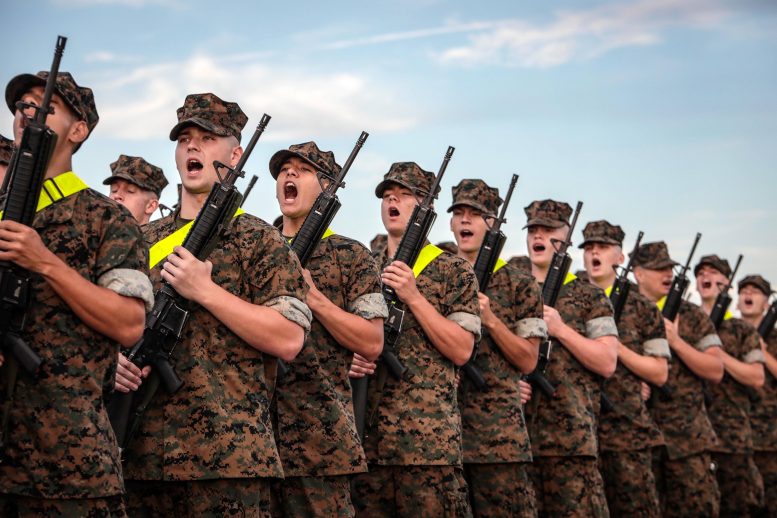
Recruits with India Company, 3rd Recruit Training Battalion, prepare and practice for their initial drill evaluation on Peatross Parade Deck on Parris Island, S.C. Credit: U.S. Marine Corps photo by Sgt. Dana Beesley
A study of nearly 2,000 Marine recruits who went through supervised quarantine before starting basic training revealed several instances of asymptomatic transmission of SARS-CoV-2, the virus that causes COVID-19, despite the quarantine measures.
The findings have important implications for the effectiveness of public health measures to suppress transmission of COVID-19 among young adults, whether in military training, schools, or other aspects of the pandemic.
The researchers from the Icahn School of Medicine at Mount Sinai and the Naval Medical Research Center studied new Marine recruits while they were in a two-week supervised quarantine. The study results, publishing November 11 in The New England Journal of Medicine, showed that few infected recruits had symptoms before diagnosis of SARS-CoV-2 infection, that transmission occurred despite implementing many best-practice public health measures, and that diagnoses were made only by scheduled tests, not by tests performed in response to symptoms.

Stuart C. Sealfon, MD, Professor of Neurology at the Icahn School of Medicine at Mount Sinai and senior author of the paper. Credit: Mount Sinai Health System
“We were honored that the U.S. Navy gave us the opportunity to collaborate on studying SARS-CoV-2 in Marine recruits,” says Stuart Sealfon, MD, the Sara B. and Seth M. Glickenhaus Professor of Neurology at the Icahn School of Medicine at Mount Sinai. “This is a difficult infection to suppress in young people, even with close supervision of their mask wearing, social distancing, and other mitigation measures. We find that regular testing not dependent on symptoms identifies carriers who can transmit SARS-CoV-2. We hope this information helps in developing more effective measures to keep military installations and schools safe.”
The study data revealed asymptomatic spread of the virus even under strict military orders for quarantine and public health measures that most likely experienced better compliance than what would be possible in other youth settings like college campuses. The researchers noted that daily temperature and symptom checks did not detect infections among the recruits and that the virus was largely transmitted within a given platoon group where trainees tended to be near one another.
The study focused on 1,848 study participants who were enrolled from nine different Marine recruit classes, each containing 350 to 450 recruits, between May 15 and the end of July. The participants were offered enrollment in a prospective, longitudinal study after self-quarantining at home for two weeks prior to arrival at basic training. Once they arrived, they were required to follow strict group quarantine measures with two-person rooms for two weeks–the duration of the study period–before the start of the actual training. The supervised group quarantine took place at a college used only for this purpose. Each recruit class was housed in different buildings and had different dining times and training schedules, so the classes did not interact.
Each weekly class was further divided into platoons of 50-60. During the study period, all recruits wore cloth masks, practiced social distancing of at least six feet, and regularly washed their hands, and each recruit had just one roommate. Most of their instruction, including exercising and learning military customs and traditions, was done outdoors. After each class finished quarantine, a deep cleaning, using bleach on surfaces, occurred in all rooms and common areas of the dormitories before the arrival of the next class.
To determine asymptomatic and symptomatic SARS-CoV-2 prevalence and transmission during supervised quarantine, participants were tested within 2 days of arrival, at 7 days, and at 14 days using a nasal swab (PCR) test authorized for emergency use by the U.S. Food and Drug Administration. Analysis of viral genomes from infected recruits identified multiple clusters that were temporally, spatially, and epidemiologically linked, revealing multiple local transmission events during quarantine.
“The identification of six independent transmission clusters defined by distinct mutations indicates that there were multiple independent SARS-CoV-2 introductions and outbreaks during the supervised quarantine,” said Harm van Bakel, PhD, Assistant Professor of Genetics and Genomic Sciences at the Icahn School of Medicine at Mount Sinai. “The data from this large study indicates that in order to curtail coronavirus transmission in group settings and prevent spill-over to the wider community, we need to establish widespread initial and repeated surveillance testing of all individuals regardless of symptoms.”
Insight into COVID-19 characteristics and SARS-CoV-2 transmission in military personnel has relevance to developing safer approaches for related settings composed primarily of young adults such as schools, sports, and camps.
“Our study highlights the power of Navy Medicine research to deploy and overcome many logistical hurdles during a pandemic and quickly stand up an institutional review board-approved study. These results will improve the medical readiness of our Marines and should help inform public health policy across the Navy, Department of Defense, and society at large to decrease transmission of SARS CoV-2,” said Cmdr. Andrew Letizia, MD, Deputy Director of the Naval Medical Research Center’s infection disease directorate and lead researcher for the study.
Reference: “SARS-CoV-2 Transmission among Marine Recruits during Quarantine” by Andrew G. Letizia, M.D., Irene Ramos, Ph.D., Ajay Obla, Ph.D., Carl Goforth, Ph.D., Dawn L. Weir, Ph.D., Yongchao Ge, Ph.D., Marcas M. Bamman, Ph.D., Jayeeta Dutta, M.B.A., Ethan Ellis, B.S., Luis Estrella, Ph.D., Mary-Catherine George, Ph.D., Ana S. Gonzalez-Reiche, Ph.D., William D. Graham, Ph.D., Adriana van de Guchte, M.S., Ramiro Gutierrez, M.D., Franca Jones, Ph.D., Aspasia Kalomoiri, Ph.D., Rhonda Lizewski, M.D., Stephen Lizewski, Ph.D., Jan Marayag, B.A., Nada Marjanovic, M.S., Eugene V. Millar, Ph.D., Venugopalan D. Nair, Ph.D., German Nudelman, Ph.D., Edgar Nunez, A.S., Brian L. Pike, Ph.D., Chad Porter, Ph.D., James Regeimbal, Ph.D., Stas Rirak, M.S., Ernesto Santa Ana, A.S., Rachel S.G. Sealfon, Ph.D., Robert Sebra, Ph.D., Mark P. Simons, Ph.D., Alessandra Soares-Schanoski, Ph.D., Victor Sugiharto, Ph.D., Michael Termini, M.D., Sindhu Vangeti, Ph.D., Carlos Williams, M.D., Olga G. Troyanskaya, Ph.D., Harm van Bakel, Ph.D., and Stuart C. Sealfon, M.D., 11 November 2020, New England Journal of Medicine.
DOI: 10.1056/NEJMoa2029717
This work was supported by the Defense Health Agency through the Naval Medical Research Center and the Defense Advanced Research Projects Agency.





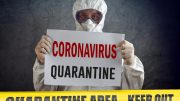
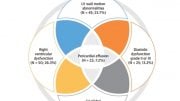
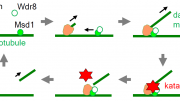
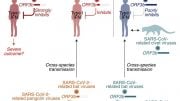
This is not a case of asymptomatic transmission but more a classic case of terrain theory over germ theory.
The PCR test is NOT to be used for diagnosis as per the inventor of the test, Dr Kary Mullis. Using this test to diagnosis is causing so much unreliability and promoting disinformation in regard to this virus…please be AWARE.
Diane, if you read the article, the researchers did viral genome analysis and identified a mutant strain among the infections detected. Viruses mutate all the time, as plus sense RNA viruses lack error correction proteases, such that perhaps only one in five virions produced are infective due to transcription errors. What the test program showed is that early viral shedding is possible at a level of viral titer which does not cause symptoms. It also shows that masks and social distancing are ineffective in limiting the spread of respiratory viruses.